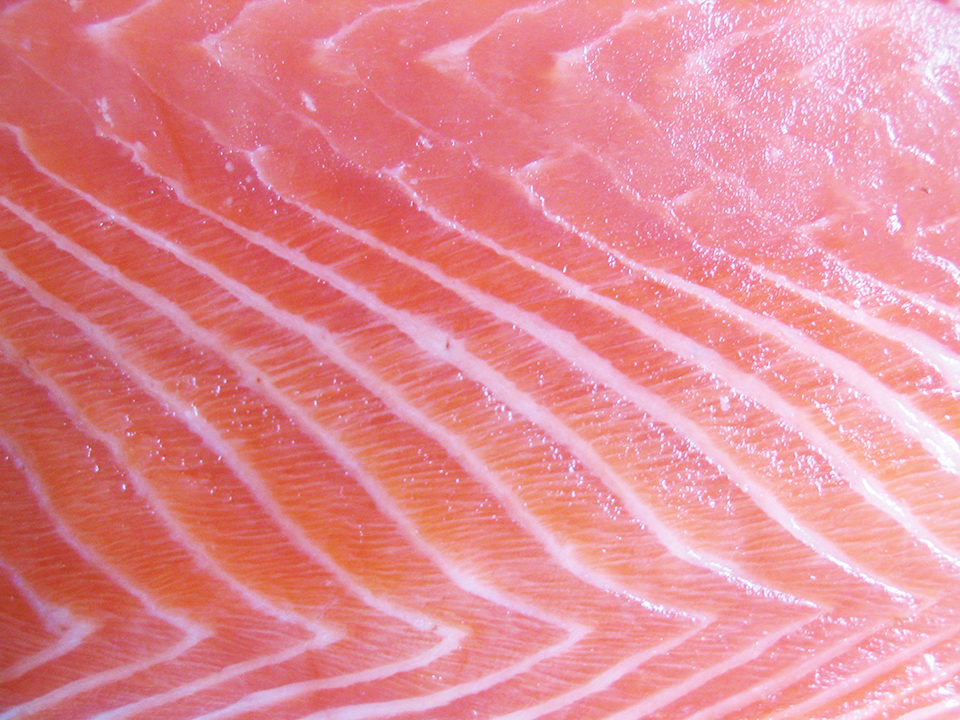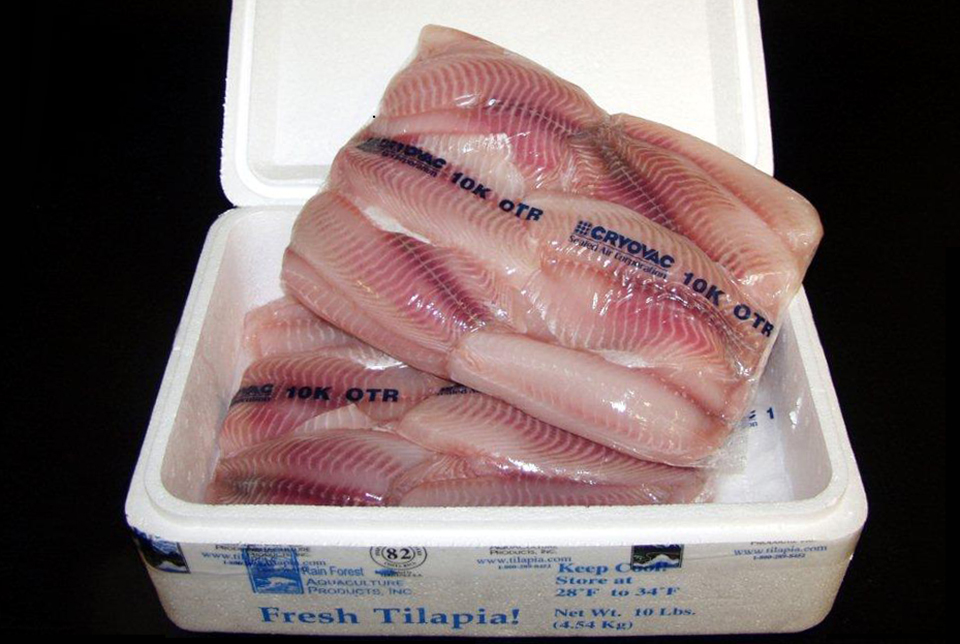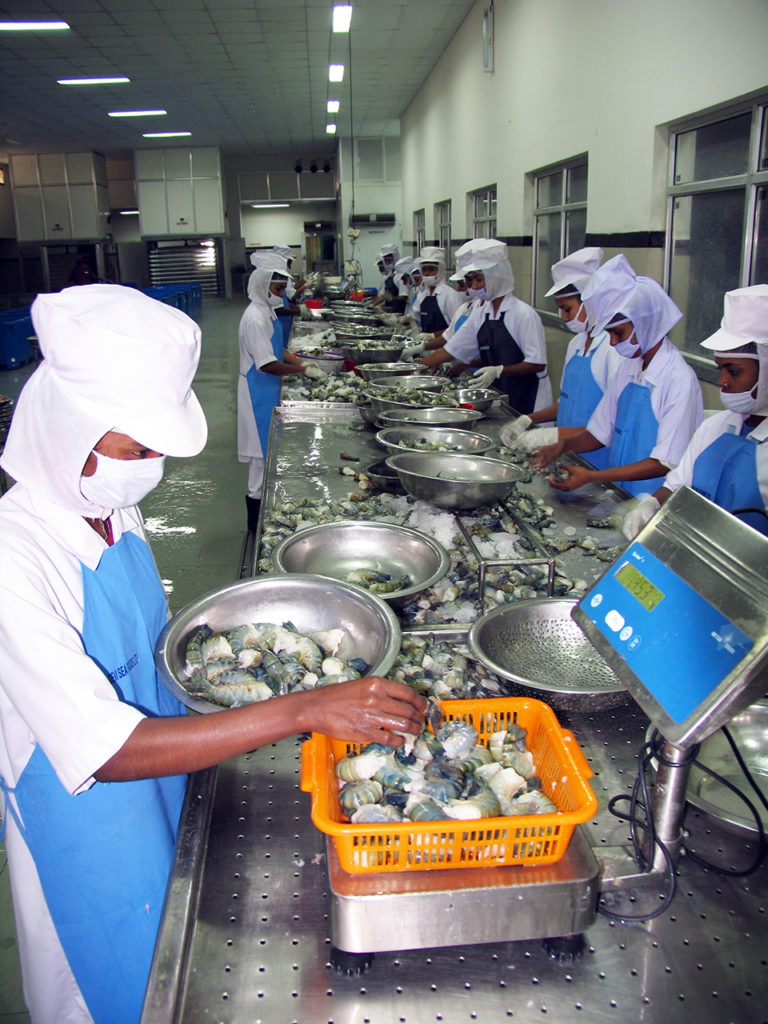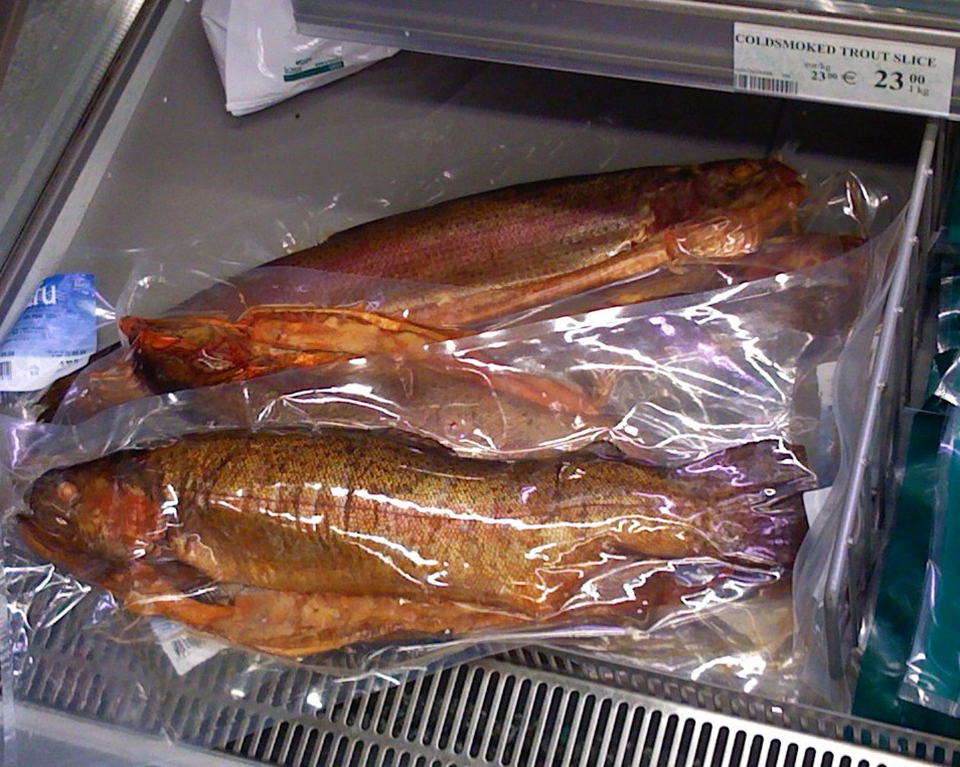Treatment in salmon processing

Although Listeria monocytogenes was isolated from a clinical specimen as early as 1891, its transmission by food was not recognized until 1981. National regulations concerning the microorganism vary.
Because approximately 25 percent of all fatalities associated with foodborne outbreaks in the United States are attributed to L. monocytogenes, the U.S. Food and Drug Administration (FDA) has adopted zero tolerance for this pathogen in ready-to-eat foods. In other countries, however, food products are not considered “adulterated” if L. monocytogenes is present in concentrations less than 50 colony forming unit per gram, provided the microorganism does not exhibit high growth rates and the source firm employs good manufacturing practices.
Fresh salmon
In fresh salmon, fish origin (wild or cultured), fishing season, fishing technique (trawling or angling), handling, and storage conditions (refrigerated or frozen) all affect the likelihood of initial contamination with L. monocytogenes. The origin of the salmon is critical: Listeria species are detected in 81 percent of fresh water samples and 30 percent of marine water samples.
This contamination comes from sewage effluents, fecal contamination by animals, and runoff from agricultural land. Therefore, the initial and most important sources of contamination in processing plants are the skin, mucus, tail, and head surfaces of fish at the time of decapitation, skinning, and filleting. Processing equipment and personnel rotation also contribute to the contamination.
During processing, fish are exposed to water from containers and thawing tanks that in 18 percent of cases are contaminated with L. monocytogenes. During filleting, the pathogen can be transferred from the external to the cut surfaces of the fish, as well as slicing machines and tables. Once these surfaces are contaminated, they also become potential sources of contamination. Brining with soaking or needle injection can also be a contaminating source. While smoking is not a source of contamination, cold smoking does not eliminate the pathogen.
Processing plants
While no L. monocytogenes was detected from salmon farms and harvested salmon in one study, several processing facilities have been contaminated with the pathogen. Five to 15 percent of gull droppings are known to contain L. monocytogenes, and because gulls are invariably present around salmon cultivation, harvesting, and processing areas, the environment should be considered a potential source of the microorganism.
One study compared two strains of L. monocytogenes at different stages of salmon processing. At low temperatures of 2, 7, and 11 degrees-C, the microorganisms survived on dry wood surfaces at least three days without added nutrients but were unrecoverable after two days at 22 degrees-C. Wood was selected for the study since wood contact surfaces are common parts of the salmon-processing environment.
When large amounts of nutrients were provided, the recoveries of L. monocytogenes at temperatures of 11 degrees-C or less were essentially unchanged over a three-day holding period, and rapid growth was observed at room temperature. L. monocytogenes grew better in the absence of natural microflora.
Live salmon
In another study, a 4.7-log colony-forming units (cfu) suspension of L. monocytogenes was orally introduced into the stomachs of live Atlantic salmon and the fish were returned to the water. No L. monocytogenes could be detected in the digestive tracts of the salmon three days after its introduction.
The eradication of the pathogen in the digestive tracts occurred regardless of whether the fish actively fed or not. A noticeable decline in the pathogen was observed as early as three hours after introduction. Therefore, the intestinal cavities of salmon are not believed to be sources of the pathogen during processing operations.
Smoked salmon
A recent draft risk assessment published by FDA and the U.S. Department of Agriculture estimated that 15 percent of all smoked fish is contaminated with L. monocytogenes. The assessment ranked hot- and cold-smoked fish products sixth in terms of relative risk for causing listeriosis on a perannum basis in intermediate-aged individuals.
A survey of cold-smoked finished product samples from processing plants producing wild-caught and aquacultured Atlantic, king, chum, and sockeye salmon was made over a six-month period. Of approximately 72 salmon samples, five were positive for Listeria, including one positive for L. monocytogenes.
For this sampling, the portions tested on days 7 and 28 of storage at 4 degrees-C contained 46 and 52 colony forming unit per gram respectively, whereas the portion tested on day 14 was negative. The data clearly showed considerable heterogeneity in Listeria distribution within a single positive smoked fish sample. Even with refrigerated storage for 28 days, none of the naturally contaminated samples reached Listeria sp. numbers greater than 100 colony forming unit pergram, which indicated the Listeria growth was limited within the storage period.
Another study showed that vacuum-packaged sliced salmon was contaminated by L. monocytogenes in 20 of 100 samples stored at 2 degrees-C and 12 of 65 packages stored at 10 degrees-C. The Listeria contamination was mainly attributed to the use of temporary laborers in the slicing and packing operations.
Smoking effects
L. innocua is similar to L. monocytogenes, and the two microorganisms exhibit somewhat similar growth characteristics. In a study, the ability of Listeria innocua to survive on salmon fillets during cold smoking in a commercial processing plant with smoking temperatures in the 18 to 30 degrees-C range and smoke times of 2-14 hours was examined.
Smoke temperature variations did not significantly reduce counts of the microorganism on the salmon. However, smoking time had a significant reduction – as much as 3 logs (99.9 percent) – when the smoking time was 12 hours. The reduction in L. innocua levels in the fish was unaffected by variations in the pH, water activity, and salt concentration of the fillets.
The microflora of spoiled cold-smoked salmon often consists of a mixture of lactic acid bacteria (LAB) and Gram-negative bacteria. The shelf life of vacuum-packed cold-smoked salmon is approximately four weeks at 5 degrees-C. In studies, the addition of nisin and/or carbon dioxide during packaging increased the shelf life to five or six weeks and limited the levels of LAB. When the lactic acid bacteria Lactobacillus sakei was added to vacuum-packaged cold-smoked salmon and incubated at 10 degrees-C for four weeks, a bacteriocin produced by the bacterium had an initial inhibiting effect on the growth of L. monocytogenes.
Biopreservation
Biopreservation, which is the practice of inoculating food products with selected bacteria to inhibit the growth of undesirable microorganisms, is garnering considerable interest in controlling the risk of L. monocytogenes in cold-smoked fish. Many studies have reported the use of lactic acid bacteria as protective cultures in a range of ready-to-eat foods.
In cold-smoked fish, the natural microflora are frequently dominated by LAB, in which the Carnobacterium genus is often represented. Carnobacterium species are good candidates for a biopreservation strategy, as many strains secrete antimicrobial compounds called bacteriocins that are capable of inhibiting related bacteria such as L. monocytogenes. Moreover, they are not believed to have any adverse effect on the sensory properties of the fish.
A study in which sterile cold-smoked fish was coinoculated with Carnobacterium and mixtures of L. monocytogenes strains showed that the level of L. monocytogenes was maintained below 50 cfu per gram during four weeks of storage at 4 and 8 degrees-C, regardless of the sensitivity of the pathogen strains.
Salt treatment
At 10 degrees-C, 6 percent sodium chloride reduced L. monocytogenes counts by 1 log (90 percent) after 30 days storage under oxygen-permeable conditions, where-as no significant effect from sodium chloride was observed under vacuum packaging. At 4 degrees-C, increasing salt concentration 3-6 percent reduced L. monocytogenes 2-5 logs (99-99.999 percent) under oxygen-permeable conditions. Unfortunately, as salt concentration increases over 3 percent, consumer rejection also increases. A 6 percent salt concentration is unacceptable to almost all consumers.
High-pressure processing
High-pressure processing can inactivate some spoilage and pathogenic microorganisms in foods. Unfortunately, pressures of 150, 200, and 250 MPa are unable to prevent the growth of L. monocytogenes or spoilage of cold-smoked salmon. Processing at 250 MPa caused lag phases of 17 and 10 days in L. monocytogenes at approximately 5 and 10 degrees-C, respectively.
High-pressure processing at 200 MPa had marked effects on both the color and texture of the cold-smoked salmon. Pressure at levels of 300 MPa gave lighter-colored products, and both pressure and storage times significantly affected cutting strength. TBAR values, an indicator of lipid oxidation, increased with increased pressure and storage time.
Quality factors
Product quality can be best maintained by smoking fresh fish with high fat content in the muscle tissue, freezing fish after and not before smoking, storing smoked fish at superchilled temperatures in the processing facility, and encouraging distributors and retailers to ensure the fish is kept at temperatures as close as possible to 0 degrees-C.
(Editor’s Note: This article was originally published in the April/May 2006 print edition of the Global Aquaculture Advocate.)
Now that you've reached the end of the article ...
… please consider supporting GSA’s mission to advance responsible seafood practices through education, advocacy and third-party assurances. The Advocate aims to document the evolution of responsible seafood practices and share the expansive knowledge of our vast network of contributors.
By becoming a Global Seafood Alliance member, you’re ensuring that all of the pre-competitive work we do through member benefits, resources and events can continue. Individual membership costs just $50 a year.
Not a GSA member? Join us.
Author
-

George J. Flick, Jr., Ph.D.
Food Science and Technology Department
Virginia Tech/Virginia Sea Grant (0418)
Blacksburg, Virginia 24061 USA
Tagged With
Related Posts

Intelligence
An examination of seafood packaging
Some substances can migrate from plastics and other seafood packaging materials into the product. Even if the substances are not harmful, they can affect the flavor and acceptability of the food.

Intelligence
Byproduct utilization for increased profitability, part 5
Fish protein hydrolysates have been used in the food industry for the development of antioxidants, emulsifiers, flavoring agents, anti-bacterial agents and feed. As natural products, they have a growing acceptance, since natural products are preferred by some consumers over industrial products.

Intelligence
Post-harvest quality of freshwater prawns, part 2
Freshwater shrimp can contain pathogenic bacteria that cause illness unless care is exercised by producers, retailers and consumers. Many of the human pathogens can survive frozen storage, but are killed or inactivated by thermal processes.

Intelligence
Smoked fish, part 1
The objectives of the smoking process are to uniformly impart the desired sensory characteristics to the product, extend shelf life and avoid the deposition of harmful compounds.


